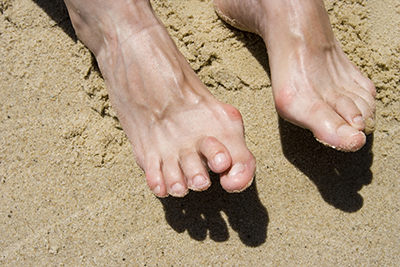Dallas Metro / North Texas
(214) 710-1028
Hammertoes

Hammertoes are abnormal contractures of one or both joints of the lesser digits. This abnormal contracture of the joints puts pressure on the toes during shoe wear eliciting pain and forming skin lesions. Skin lesions on top of the toes are usually corns which are formed as a result of constant shoe pressure on a focal small area of bony prominence. Skin lesions on the bottom of the toe at the ball of the foot are usually calluses which are formed as a result of weight-bearing pressure over a more diffuse area. Corns and calluses can be painful lesions.
Hammertoes are progressive deformities that start out as flexible and manually reducible with manageable symptoms or having no symptoms at all. Conservative treatments can alleviate symptoms readily. However over time, hammertoes that are not treated do become progressively worse. They become rigid and are not manually reducible. The rigidity presents as bony prominences dorsally and are easily irritated with shoewear pressure. They are not responsive to noninvasive forms of treatment and will require surgery to correct the deformities. Corns and calluses do form, and they may also develop into open sores. Hammertoes usually never get better without some sort of eventual surgical intervention. This is especially true of diabetics who are at risk of losing toes due to having hammertoes that will ulcerate infecting bone.
Hammertoes are usually the result of muscle and tendon imbalances as a result of mechanical changes that occur over time. Any biomechanical changes that alter how extensor and flexor tendons relate to each other will cause the toes to bend and contract out of harmony. Shoes that don’t fit properly and crowd the toes will exacerbate hammertoe formation and irritate existing hammertoes. Improper sized shoes can also lead to the contracture and bending of the little toe. In addition, a broken toe can also heal into a rigid hammertoe. In some cases, hammertoe formation may be an inherited phenomenom.
The foot and ankle surgeon will consider both conservative and surgical treatments for hammertoes. Palliative care may involve just paring the corns and calluses followed by padding of the lesions to shield them from further irritation. Other conservative treatments include wearing shoes with wider toe box, wearing orthotics that would reduce contractures, taking anti-inflammatory medications, and wearing digital splints/strappings that somewhat assist in realigning the toes.
Conservative treatments do not provide long term resolution as the hammertoes and associated pathologies do readily recur. Surgery is required in order to address the underlying problems. Especially once the hammertoes become rigid, surgical correction is the only way to correct the contracture deformities. The most common surgical procedure to correct a hammertoe is an arthroplasty where a small section of bone is removed from the affected joint. Another procedure is arthrodesis where the bones of the joint are fused to straighten the toe after an arthroplasty is performed. The toe is then maintained in a straightened position with fixation while it is healing. The foot and ankle surgeon will determine whether to perform an arthroplasty or arthrodesis based on intra-operative evaluation of the tendons that affect the toe. Associated surgical procedures may involve excising skin with the corn and addressing the balancing of the tendons.
Many patients with hammertoes also have bunions which are corrected at the same time while in surgery.




